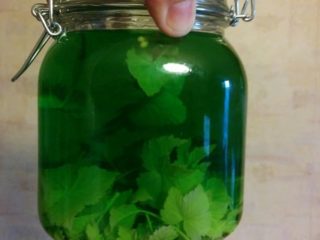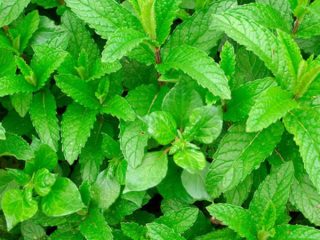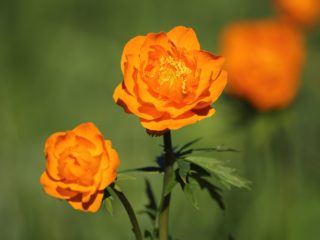Content
The Altai bather (Trollins altaicus), or the Altai light, is a herbaceous raceme with medicinal properties, belonging to the Buttercup family. It has been cultivated as an ornamental garden plant for nearly one and a half hundred years (since 1874). Especially popular in Europe. Listed in the Red Book of Uzbekistan.
Botanical description of the species
The Altai bather is a bush 0.8-0.9 m high with single erect, simple (occasionally branching) leafy stems ending in buds. The flower arrow of the plant emerges from the root rosette (about 25-30 cm in height), consisting of long-petiolate, palmate-divided into 5 diamond-shaped segments almost to the very base of the leaf plates, which have the shape of a regular pentagon (5-12 cm in diameter). Few stem leaves, much smaller towards the apex, lower ones on petioles, upper ones sessile.
Spherical, not too large (up to 4-5 cm) flowers of the Altai swimsuit are collected from 10-20 bright golden-yellow or rich orange broad-ovate sepals, which have a reddish sheen outside. Widened at the base and pointed at the apex, nectary petals of a juicy orange-red hue. Anthers of a darker color are purple. In the fully opened flower of the Altai fire, black stamens are clearly visible.
The flowering of the swimsuit begins in the first half of May and lasts about three weeks, sometimes at the end of summer (August), it is possible to repeat it. In place of the crumbling buds, after a few weeks, round leaflet fruits are formed, filled with shiny, black, slightly ribbed seeds.
Growing area
Wild Altai bathers prefer to settle in meadows and fields, forest edges, in fir forests and along the banks of water bodies. They are often found in the Siberian District, Altai, as well as in Mongolia, northern China and Central Asia. Altai light grows at an altitude of about 0.9-2.3 km above sea level, along the border of the forest belt.
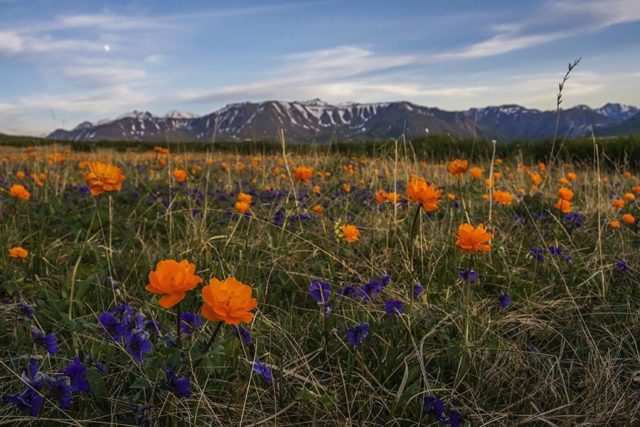
Lights are often found in the foothills of Altai, for which they got their name
Application in breeding
On the basis of three wild-growing swimsuits (Altai, European and Chinese), through several crosses, breeders have bred a hybrid variety - a cultural bathing suit (Trollins cultorum). Using a hybrid, they create a variety of new forms and varieties of swimwear with almost white or pale lemon flowers.
Medicinal properties and contraindications
All parts of the Altai swimsuit are considered poisonous; not only flowers, but also stems with leaves are used for medicinal purposes. The petals and greens contain: saponins, alkaloids, coumarins, flavonoids, choline, lipase, phenol carboxylic acids, vitamin C. The fire seeds contain fatty oils (more than 30%).
The dried Altai bathing suit has pronounced wound healing, absorbable, anti-inflammatory and decongestant properties. In folk medicine, decoctions, creams, ointments and infusions made on the basis of this plant are used. Healers and healers treat with the Altai fire:
- hemorrhoids;
- scabies;
- stomach diseases;
- swelling;
- scurvy;
- epilepsy;
- abscesses and festering wounds;
- furunculosis;
- infectious hepatitis;
- long healing and bleeding wounds;
- dropsy;
- kidney and liver diseases;
- female diseases (violation of the cycle).
Any medicines from the Altai bathing suit are absolutely contraindicated during pregnancy, breastfeeding, as well as in case of individual intolerance and allergic manifestations.
Is it possible to grow at home
The Altai bather is easy to grow in a garden or on a personal plot, since this unpretentious culture does not require any specific techniques. The process begins by collecting and drying the seeds of the flame. Before planting, the seed is cold stratified. To do this, the seeds are mixed with slightly damp sand and kept in a bag on the lower shelf of the refrigerator (at + 2-4 ° C), designed for storing vegetables.
After waiting 3-4 months (usually in March), the swimsuit is sown in a container or box with a light soil mixture, then the containers are kept in a warm (+ 20-22 ° C) and bright place. Seedlings do not appear quickly, not earlier than the second half of April, or even only at the beginning of May. The seedlings of the light are well watered and covered from the scorching sun, dive after the formation of 2-3 full-fledged leaves. In the open ground on the site, the seedlings of the Altai swimsuit are relocated in August.
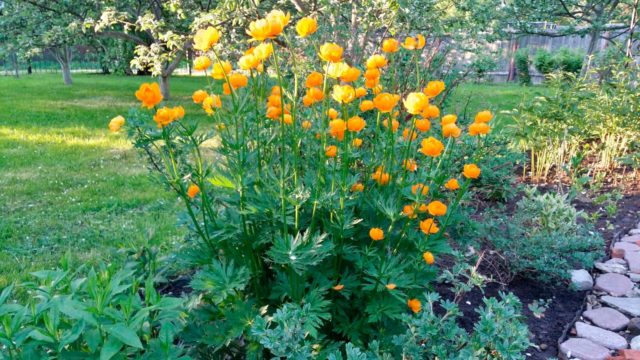
The lights in the garden look pretty unusual.
For the Altai swimsuit, a well-lit and open area with a humus, fertile, structured soil of neutral acidity is selected. Humus and peat are added to poor soil before planting (2-3 kg per m2). Altai light bushes grown through seedlings bloom only for 3-4 years.
Further care of the swimsuit is as follows:
- Regular and abundant watering, especially in hot weather. Only water heated by the sun can be used to irrigate the Altai light.
- Top dressing during flowering with any complex fertilizer (Agricola, nitrophoska, etc.).
- Weeding. It is not necessary to loosen the plantings of the Altai swimsuit, since its roots are very superficial and easily damaged. Better to just cover the ground under the bushes.
- Pruning. The faded heads of the Altai light are removed. In the fall, cut off all the withered foliage at the root.
Swimsuits do not need any shelter for the winter. Altai lights survive well even the most severe Siberian frosts.
The swimsuit can be propagated by dividing the rhizome of an adult (4-5 years old) overgrown bush. At the end of August or in the first week of September, the plant is completely dug up and cut (chopped) into pieces, each of which has its own roots and renewal buds. Then the resulting delenki of the Altai light are planted in the right places, slightly deepening (by 1.5-2 cm) the root collar.
Conclusion
The Altai bather is a plant that is not yet very common in gardens and in personal plots. However, its unusual and natural appearance is able to give a certain zest and wild flavor to artsy cultural plantings. This quality makes the Altai light very promising in horticulture.


